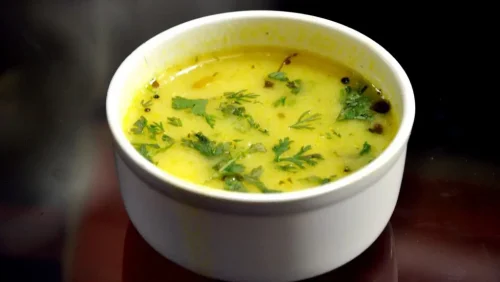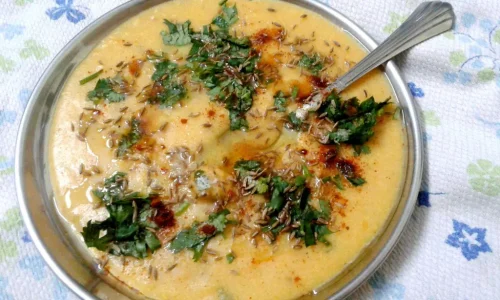Embark on a flavour rollercoaster with Gujarati food! From the sweet and salty dance of Dhokla to the spicy kick of Thepla, your taste buds are in for a treat.

Image Credit: Dheerajk88, CC BY-SA 4.0 via Wikimedia Commons
And don’t even get us started on the thali—it’s like a culinary symphony with Shak, Dal, Kadhi, and all the chutneys you could dream of. Finish it off with some Mohanthal or Shrikhand, and you’ve got a meal that’s pure bliss.
Exploring the Rich and Diverse World of Gujarati Cuisine
Gujarati food, hailing from the western state of Gujarat in India, is a vibrant and diverse culinary tradition that reflects the region’s rich cultural heritage. Known for its distinct flavours and innovative use of ingredients, Gujarati food is predominantly vegetarian, catering to the dietary preferences of a largely Hindu population. The cuisine masterfully balances sweet, salty, and spicy tastes, creating a unique gastronomic experience that delights the palate.
Staples of Gujarati food includes a variety of lentils, grains, and vegetables, often prepared with aromatic spices and herbs. Dishes like Dhokla, a steamed savoury cake made from fermented rice and chickpea batter, and Thepla, a spiced flatbread made from whole wheat flour and fenugreek leaves, are quintessentially Gujarati and widely enjoyed. The cuisine also features an array of farsan (snacks) such as Khandvi and Patra, which are as nutritious as they are flavourful.
A typical Gujarati thali (platter) is a culinary journey in itself, comprising a harmonious assortment of dishes like Shak (vegetable curry), Dal (lentil soup), Kadhi (yogurt-based curry), and an assortment of chutneys and pickles. Sweets play a significant role in Gujarati cuisine, with delicacies like Mohanthal, Puran Poli, and Shrikhand offering a perfect end to any meal.
What sets Gujarati food apart is its emphasis on using fresh, seasonal produce and traditional cooking techniques that have been passed down through generations. The cuisine’s reliance on vegetarian ingredients, combined with its inventive use of spices and flavours, makes it not only delicious but also healthful. Whether you are indulging in a festive feast or enjoying a simple home-cooked meal, Gujarati food offers a delightful culinary experience that is both comforting and nourishing.
Rotli, dal or kadhi, rice, and shaak make up a classic Gujarati thali (a dish made up of several different combinations of vegetables and spices, which may be either spicy or sweet). Gujarati food varies greatly in flavour and heat, based on the preferences of a family as well as the Gujarati region to which they belong. However, there’s not just one Gujarati food dish that will make your mouth water. Check out the delectable Gujarati food that you must try.
Undhiyu
Gujarati vegetarian cuisine is defined by undhiyu, a one-pot vegetable casserole meal. Undhiyu preparation takes a long period and requires patience. The vegetables are traditionally boiled or fried in batches. Pooris and aamras or shrikhand are the greatest accompaniments to undhiyu. This nutritious vegetable casserole goes well with soft phulkas, jowar roti, or bajra roti.

Image Credit: Subhashish Panigrahi, CC BY-SA 4.0 via Wikimedia Commons
Dabeli
It is a Gujarati food, rather, street cuisine that originated in the Kutch region. Kutchi dabeli, kachchhi dabeli, and kacchi dabeli are some of the other names for dabeli. Dabeli is a spicy, sour, and sweet potato filling served within a pav (Indian bread), drizzled with a spicy and sweet chutney and garnished with pomegranate, grapes, onions, and sev (fried gramme flour vermicelli). It’s a famous street food that can be found in both Mumbai and Gujarat. masala or spicy peanuts

Image Credit: Bharat Mirchandani from Mumbai, India, CC BY-SA 2.0 via Wikimedia Commons
Khichu
It is a rice flour-based Gujarati traditional food delicacy recipe that is both healthful and delicious. It is commonly offered as a snack as street food in Gujarat, but it can also be served for breakfast in the morning. It is really basic and easy to create, but it produces one of the most delicious and healthy snack recipes for people of all ages. Just before serving, sprinkle it with dried fruits.

Image Credit: Kanikatwl, CC BY-SA 4.0 via Wikimedia Commons
Lilva Kachori
Lilva ni kachori (fresh tuvar kachori) is a popular Gujarati food and a great winter appetizer (green pigeon peas). The name lilva kachori comes from the Gujarati word lilva, which means fresh tuvar beans. With a flaky crisp crust and a soft, lightly spicy, sweet and tangy interior, this lilva kachori recipe makes one of the tastiest kachori. With green chutney, saunth chutney, or mint chutney, serve lilva kachori hot or warm.
Khakhra
Gujarati Khakhra is a whole wheat flour snack that can be eaten for breakfast, tea, or even as a travel snack. It’s nutritious because it’s made with whole wheat flour and gently flavoured with fenugreek, turmeric, and asafoetida. Although they are commonly available in retail stores these days, they have a unique flavour when made at home. For tea time munchies, serve Gujarati Khakhra Recipe with Jowar Dhani Chivda and Masala Chai.

Image Credit: Eva Bronzini via pexels
Chorafali: The Crispy Delight of Gujarati Snacks
Chorafali, a beloved Gujarati snack, is a crispy and airy treat that has won the hearts of many across India. Made primarily from a mixture of gram flour (besan) and urad dal flour, this snack is deep-fried to perfection, resulting in light and crunchy strips that practically melt in your mouth.
What sets Chorafali apart is its unique texture and the delightful blend of spices that accompany it. Typically seasoned with a tangy mixture of red chilli powder and black salt, Chorafali offers a burst of flavour with each bite. Traditionally enjoyed during the festive season of Diwali, it has become a year-round favourite for those craving a savoury and spicy snack.
The preparation of Chorafali requires skill and precision, especially when rolling out the dough to achieve the perfect thinness for optimal crispiness. Whether you’re enjoying it as a tea-time snack or serving it as an appetizer during celebrations, Chorafali brings a taste of Gujarat’s culinary ingenuity to your plate.
This traditional Gujarati food, which tastes like papad or chips and melts in your mouth, is traditionally eaten during the annual Diwali holiday. It is one of the most appealing snacks due to its sour and spicy spice of chilli powder and dry mango powder. During Diwali, chorafali is accompanied by a unique chutney.
Gujarati Kadhi
Gujarati kadhi is a sweet-sour yoghurt kadhi made without fritters made from chickpea flour. Kadhi is a yoghurt-based gravy dish to which chickpea flour/besan is added, tempered, and then cooked with spices. Gujarati kadhi is thin and sweet due to the use of jaggery/sugar, and unlike Punjabi kadhi, no pakora is used. Serve hot gujarati kadhi over rice or phulka, garnished with chopped coriander.
Handvo
It’s a recipe for a healthy and delicious mixed lentil vegetable cake from popular Gujarati cuisine. Typically, it is made using besan or a combination of lentils. It’s usually made using lauki or bottle gourd and blended lentil dough, then cooked until it has a cake-like texture. For breakfast and snacks, it’s usually served with a spicy green chutney.
Gathiya
Deep frying a spicy besan mixture is a popular tea-time Gujarati delicacy. The recipe is comparable to farsan or kara sev, except it is less crispy and melts in your tongue like butter. In certain parts of Gujarat, this savoury and crispy food is also referred to as ganthia recipe. It is quick and simple to cook and is enjoyed by children, adults, and people of all ages.
Ghari
Ghari is a sweet dish from the Surat region of Gujarati cuisine. Puri dough, milk ‘mawa,’ ghee, and sugar are combined to make ghari, which are shaped into circular forms with a sweet filling and eaten during the Chandani Padva festival. It also comes in a variety of flavours and variants, including kesar (saffron) pistachio, almond-elachi, and mawa (Milk solid).
The Rich Heritage and Health Benefits of Gujarati Cuisine
Gujarati cuisine stands as a testament to the region’s rich cultural heritage and innovative culinary practices. With its roots deeply embedded in vegetarianism, the cuisine offers a diverse array of flavours and dishes that cater to both traditional and modern palates. The balanced use of sweet, salty, and spicy elements creates a harmonious dining experience that is both unique and delightful.
The emphasis on fresh, seasonal ingredients and traditional cooking techniques ensures that Gujarati dishes are not only delicious but also nutritious. Lentils, grains, and a variety of vegetables form the backbone of this cuisine, providing essential nutrients and health benefits. Dishes like Dhokla, Thepla, and Kadhi are not just flavourful but also packed with proteins, vitamins, and minerals.
Gujarati cuisine’s versatility allows for a wide range of preparations, from everyday meals to festive feasts, making it an integral part of India’s culinary landscape.
A lesser-known fact about Gujarati cuisine is its significant Jain influence. Jainism, which advocates non-violence and vegetarianism, has shaped many of the culinary practices in Gujarat. This influence is evident in the widespread use of root vegetables like potatoes and carrots, which are avoided by devout Jains, in favour of alternative ingredients.
Gujarati cuisine’s versatility allows for a wide range of preparations, from everyday meals to festive feasts, making it an integral part of India’s culinary landscape. Whether you are enjoying a simple Thepla with chutney or indulging in a lavish thali, Gujarati food offers a culinary journey that is rich in history, culture, and health benefits.
Read more: Latest



